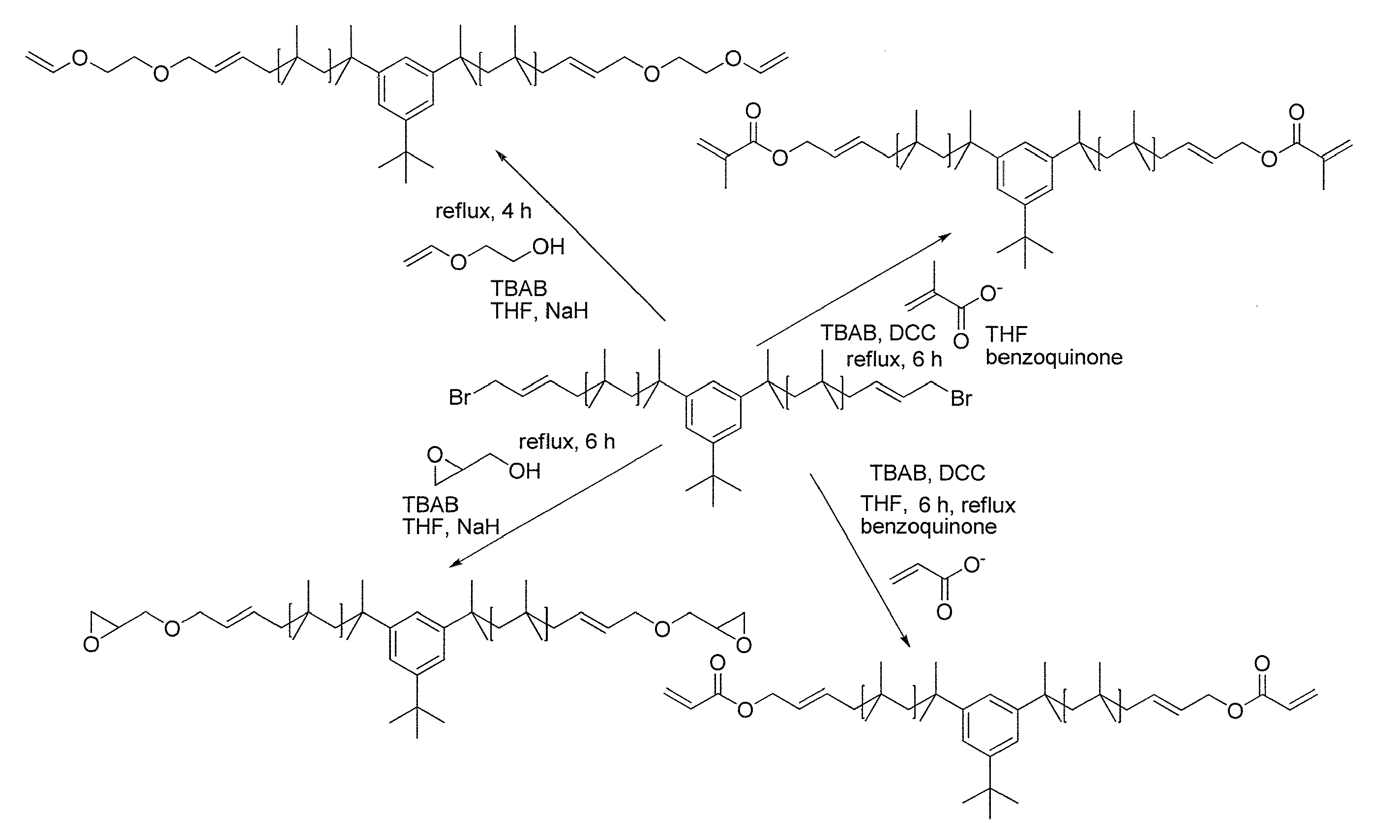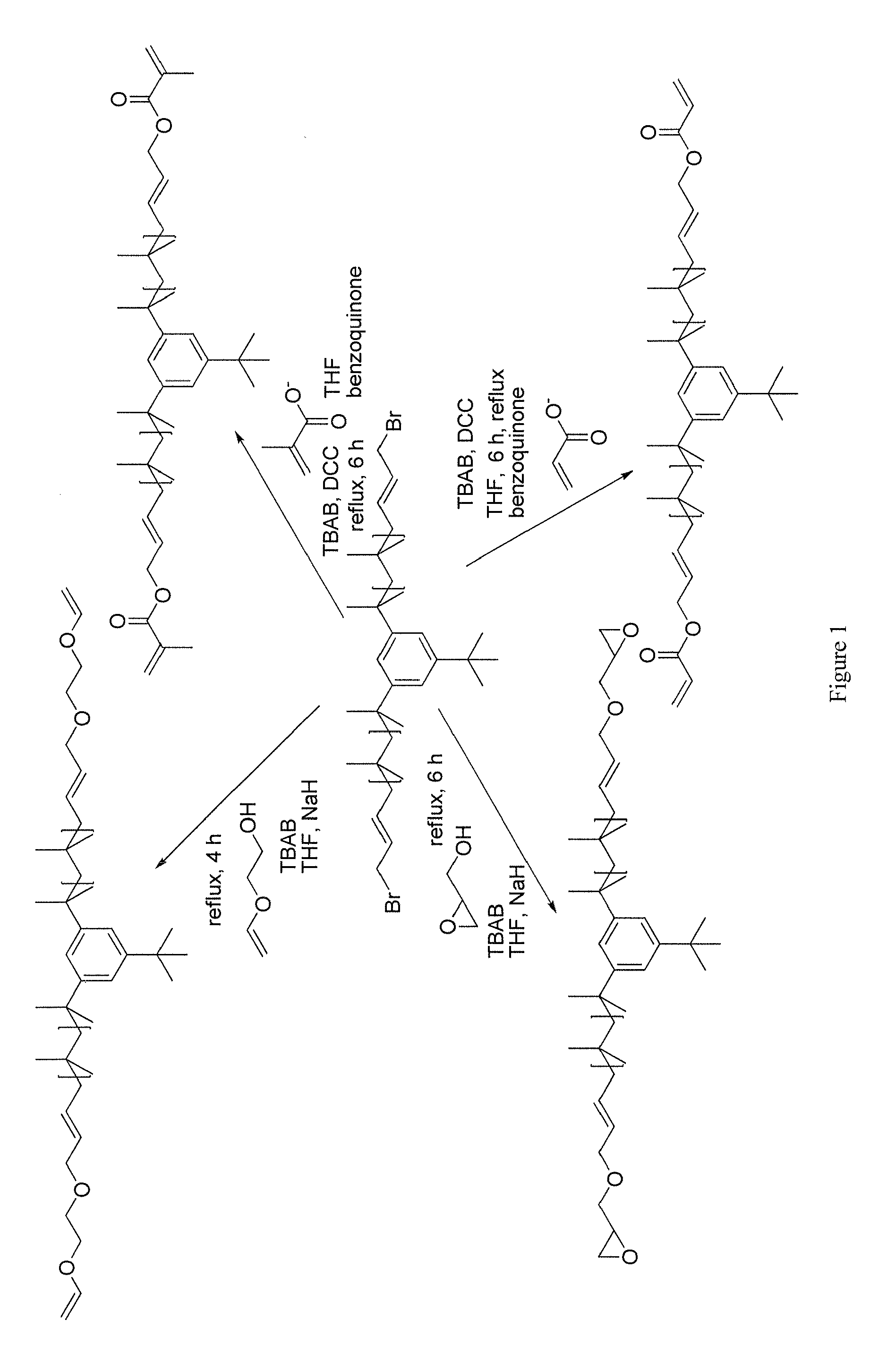Functional Polyisobutylene Based Macromonomers And Methods For Making And Using The Same
a polyisobutylene and macromonomer technology, applied in the field of functional polyisobutylene based macromonomers and methods for making and using the same, can solve the problems of laborious and expensive, incomplete end-functionalization, and inability to readily available, and achieve the effect of convenient and economical preparation
- Summary
- Abstract
- Description
- Claims
- Application Information
AI Technical Summary
Benefits of technology
Problems solved by technology
Method used
Image
Examples
example 1
Synthesis of Methacrylate End-Functional Polyisobutylene
[0108]Bromo end-functional PIB (Mn=1200, PDI=1.09, 200 mg, 0.166 mmol) was dissolved in dry THF (5 mL) and was added into a two necked glass reactor followed by the addition of sodium methacrylate (0.045 mg, 0.42 mmol), TBAB (135 mg, 0.42 mmol) and 1,4 benzoquinone (to prevent homopolymerization of end group) (5 mg, 0.005 mmol); the mixture was heated at 65° C. under a dry nitrogen atmosphere for 6 h. The reaction mixture was cooled to room temperature, and THF was evaporated using rotary vacuum evaporator. The residue was dissolved in hexane and the solution was filtered and the filtrate (polymer solution) was precipitated in methanol. The polymer was allowed to settle down at the bottom. The supernatant liquid was decanted off and the sticky mass was dried under vacuum at room temperature for 12 h. Gravimetric yield: 98%, GPC-MALLS: Mn=1500, PDI=1.11. 1H NMR (CDCl3, ppm, δ): 4.6 (d, 2H, CH2OCOCH3C═CH2), 5.65 (m, 1H, —CH═CHCH2...
example 2
Synthesis of Acrylate End-Functional Polyisobutylene
[0109]Bromo end-functional PIB (Mn=1200, PDI=1.09, 200 mg, 0.166 mmol) was dissolved in dry THF (5 mL) and was added into a two necked glass reactor followed by the addition of sodium acrylate (0.045 mg, 0.42 mmol), TBAB (135 mg, 0.42 mmol) and 1,4 benzoquinone (to prevent homopolymerization of end group) (5 mg, 0.005 mmol); the mixture was heated at 65° C. under a dry nitrogen atmosphere for 6 h. The reaction mixture was cooled to room temperature, and THF was evaporated using rotary vacuum evaporator. The residue was dissolved in hexane and the solution was filtered and the filtrate (polymer solution) was precipitated in methanol. The polymer was allowed to settle down at the bottom. The supernatant liquid was decanted off and the sticky mass was dried under vacuum at room temperature for 12 h. Gravimetric yield: 98%, GPC-MALLS: Mn=1400, PDI=1.11. 1H NMR (CDCl3, ppm, δ): 4.65 (d, 2H, CH2OCOCH═CH2), 5.60 (m, 1H, —CH═CHCH2OCOCH═CH2...
example 3
Synthesis of Epoxy End-Functionl Polyisobutylene
[0110]Bromo end-functional PIB (Mn=1200, PDI=1.09, 800 mg, 0.66 mmol) was dissolved in dry THF (5 mL). Glycidol (495 mg, 6.6 mmol), NaH (40 mg, 1.65 mmol) and TBAB (1.06 g, 3.3 mmol) were added and the mixture was refluxed under a dry nitrogen atmosphere for 1.5 h. The reaction mixture was cooled to room temperature, and THF was evaporated. The residue was dissolved in hexanes, the solution was filtered and the filtrate was reprecipitated in methanol. The product obtained was further purified by dissolution and reprecipitation using hexanes and methanol. The product polymer was finally dried under vacuum at room temperature. Gravimetric yield: 97%, GPC-MALLS: Mn=1300, PDI=1.15. Yield: 95%. 1H NMR (CDCl3, ppm, δ): 4.05 (m, 2H, CH2OCH2(CHOCH2)), 5.55 (m, 1H, CH═CHCH2OCH2(CHOCH2)), 5.75 (m, 1H, —CH═CHCH2OCH2(CHOCH2)), 3.7 and 3.4 (d, 2H, —OCH2(CH2OCH)), 3.2 (m, 1H, —(CHOCH2), 2.8 and 2.6 (m, 1H, (CHOCH2). 13C NMR (CDCl3, ppm, δ): 149 (C═C...
PUM
| Property | Measurement | Unit |
|---|---|---|
| Dielectric constant | aaaaa | aaaaa |
Abstract
Description
Claims
Application Information
 Login to View More
Login to View More - R&D
- Intellectual Property
- Life Sciences
- Materials
- Tech Scout
- Unparalleled Data Quality
- Higher Quality Content
- 60% Fewer Hallucinations
Browse by: Latest US Patents, China's latest patents, Technical Efficacy Thesaurus, Application Domain, Technology Topic, Popular Technical Reports.
© 2025 PatSnap. All rights reserved.Legal|Privacy policy|Modern Slavery Act Transparency Statement|Sitemap|About US| Contact US: help@patsnap.com



